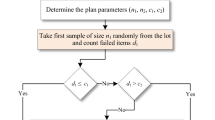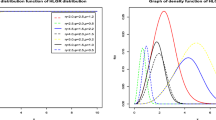Abstract
This paper considers the statistical inference for the competing risks model from generalized Rayleigh distribution based on progressive Type-II censoring when the parameters of the latent lifetime distributions are different or common. Maximum likelihood estimates are obtained, where the existence of the point estimators are proved, and the confidence intervals are established via the observed Fisher information matrix as well. Bayesian estimates of unknown parameters and reliability characteristics are derived under symmetric and asymmetric loss functions, and Monte Carlo Markov Chain sampling method is used to compute the Bayesian point estimates and the highest posterior density credible intervals. In addition, Bootstrap methods are also considered to obtain bias-corrected point estimates and approximate confidence intervals. Then we carry out hypothesis test using likelihood ratio test statistics. Monte Carlo simulation and a set of real data are presented to assess the performance of our proposed methods. Finally, the optimal censoring scheme issue is studied.




Similar content being viewed by others
References
Ali S (2015) On the Bayesian estimation of the weighted lindley distribution. J Stat Comput Simul 85(5):855–880
Aslam M, Ali S, Yousaf R, Shah I (2020a) Mixture of transmuted Pareto distribution: properties, applications and estimation under Bayesian framework. J Franklin Inst 357(5):2934–2957
Aslam M, Noor F, Ali S (2020b) Shifted exponential distribution: Bayesian estimation, prediction and expected test time under progressive censoring. J Test Eval 48(2):1576–1593
Balakrishnan N, Aggarwala R (2000) Progressive censoring: theory. Methods and applications. Birkhäuser, Boston
Balakrishnan N, Sandhu R (1995) A simple simulational algorithm for generating progressive Type-II censored samples. Am Stat 49(2):229–230
Basak I, Balakrishnan N (2017) Prediction of censored exponential lifetimes in a simple step-stress model under progressive Type II censoring. Comput Stat 32:1665–1687
Chacko M, Mohan R (2019) Bayesian analysis of weibull distribution based on progressive Type-II censored competing risks data with binomial removals. Comput Stat 34(1):233–252
Cox DR (1959) The analysis of exponentially distributed lifetimes with two types of failure. J R Stat Soc Ser B (Methodol) 21(2):411–421
Cramer E, Schmiedt AB (2011) Progressively Type-II censored competing risks data from lomax distributions. Comput Stat Data Anal 55(3):1285–1303
Guo L, Gui WH (2018) Statistical inference of the reliability for generalized exponential distribution under progressive Type-II censoring schemes. IEEE Trans Reliab 67(2):470–480
Hall P (1997) The bootstrap and edgeworth expansion. Springer, New York
Huang SR, Wu SJ (2017) Optimal sample size allocation for accelerated life test under progressive type-II censoring with competing risks. J Stat Comput Simul 87(1):1–16
Krishna H, Goel N (2018) Classical and Bayesian inference in two parameter exponential distribution with randomly censored data. Comput Stat 33:249–275
Kundu D, Pradhan B (2011) Bayesian analysis of progressively censored competing risks data. Sankhya B 73(2):276–296
Lawless JF (2003) Statistical models and methods for lifetime data. Wiley, New York
Meintanis SG (2008) A new approach of goodness-of-fit testing for exponentiated laws applied to the generalized Rayleigh distribution. Comput Stat Data Anal 52(5):2496–2503
Min W, Shi YM (2016) Bayes estimation and expected termination time for the competing risks model from Gompertz distribution under progressively hybrid censoring with binomial removals. J Comput Appl Math 300(C):420–431
Ng HKT, Chan PS, Balakrishnan N (2004) Optimal progressive censoring plans for the Weibull distribution. Technometrics 46(4):470–481
Pareek B, Kundu D, Kumar S (2009) On progressively censored competing risks data for Weibull distributions. Comput Stat Data Anal 53(12):4083–4094
Raqab MZ, Kundu D (2006) Burr type X distribution: revisited. J Probab Stat Sci 4(2):179–193
Sarhan AM (2007) Analysis of incomplete, censored data in competing risks models with generalized exponential distributions. IEEE Trans Reliab 56(1):132–138
Surles JG, Padgett WJ (2001) Inference for reliability and stress-strength for a scaled Burr Type X distribution. Lifetime Data Anal 7(2):187–200
Surles JG, Padgett WJ (2005) Some properties of a scaled Burr Type X distribution. J Stat Plan Inference 128(1):271–280
Wang L (2018) Inference of progressively censored competing risks data from Kumaraswamy distributions. J Comput Appl Math 343:719–736
Ye ZS, Chan PS, Xie M, Ng HKT (2014) Statistical inference for the extreme value distribution under adaptive Type-II progressive censoring schemes. J Stat Comput Simul 84(5):1099–1114
Zellner A (1986) Bayesian estimation and prediction using asymmetric loss functions. Publ Am Stat Assoc 81(394):446–451
Zhang Y, Meeker WQ (2005) Bayesian life test planning for the Weibull distribution with given shape parameter. Metrika 61(3):237–249
Acknowledgements
The authors’ work was partially supported by the National Statistical Science Research Project of China (No. 2019LZ32). The authors would like to thank the editor and anonymous referees for their constructive comments and suggestions that have substantially improved the original manuscript.
Author information
Authors and Affiliations
Corresponding author
Additional information
Publisher's Note
Springer Nature remains neutral with regard to jurisdictional claims in published maps and institutional affiliations.
Appendix
Appendix
Proof of Theorem 3.1:
I. For given \(\lambda _k>0\), we have \(0<B_{ki}<1\).
(1) When \(\alpha _k\rightarrow 0^+\), then \(B_{ki}^{\alpha _k}\rightarrow 1^-\) and \(1-B_{ki}^{\alpha _k}\rightarrow 0^+\). \(\sum _{i=1}^mI(\delta _i=k)\log (B_{ki})<0\) is a constant, and we have
therefore, \(\lim \limits _{\alpha _k\rightarrow 0^+}\frac{\partial l}{\partial \alpha _k}=+\infty \).
(2) When \(\alpha _k\rightarrow +\infty \), then \(B_{ki}^{\alpha _k}\rightarrow 0^+\), similarly, \(\sum _{i=1}^mI(\delta _i=k)\log (B_{ki})<0\) is a constant, and we have
therefore, \(\lim \limits _{\alpha _k\rightarrow +\infty }\frac{\partial l}{\partial \alpha _k}\) is a negtive constant.
We can further get
So for given \(\lambda _k\), \(\frac{\partial l}{\partial \alpha _k}\) is a monotone decreasing function of \(\alpha _k\) and the equation \(\frac{\partial l}{\partial \alpha _k}=0\) has an unique solution.
II. For given \(\alpha _k>0\) and \(\alpha _k \ne 1\).
(1) When \(\lambda _k\rightarrow +\infty \), then \(B_{ki}\rightarrow 1^-\) and \(\lim \nolimits _{\lambda _k\rightarrow +\infty }B_{ki}^\prime =2x_i^2 \lim \nolimits _{\lambda _k\rightarrow +\infty } \frac{\lambda _k}{e^{(\lambda _k x_i)^2}}=0^+\),
where \(\lim \nolimits _{\lambda _k\rightarrow +\infty }2\frac{m_k}{\lambda _k}=0\), \(\lim \nolimits _{\lambda _k\rightarrow +\infty }\sum _{i=1}^m(\alpha _k-1)I(\delta _i=k)\frac{B_{ki}^\prime }{B_{ki}}=0\) and
Therefore, \(\lim \limits _{\lambda _k\rightarrow +\infty }-2\lambda _k[\cdot ]=-\infty \) such that \(\lim \limits _{\lambda _k\rightarrow +\infty }\frac{\partial l}{\partial \lambda _k}=-\infty \).
(2) When \(\lambda _k\rightarrow 0^+\), then \(B_{ki}\rightarrow 0^+\) and \(B_{ki}^\prime \rightarrow 0^+\), based on (3.4), we have
For \(\lim \limits _{\lambda _k\rightarrow 0^+}\sum _{i=1}^m(\alpha _k-1)I(\delta _i=k)\frac{B_{ki}^\prime }{B_{ki}}\), we can compute it as follows.
Hence,
We have already known \(B_{ki}^{\alpha _k}\rightarrow 0^+\) and
hence, when \(\alpha _k>1\), \(\lim \limits _{\lambda _k\rightarrow 0^+}-\sum _{i=1}^m(I(\delta _i=3-k)+r_i)\frac{\alpha _kB_{ki}^{\alpha _k-1}B_{ki}^\prime }{1-B_{ki}^{\alpha _k}}=0\), but when \(0<\alpha _k<1\),
And we can get
for arbitrary \(0<\alpha _k<1\), here \(B_{ki}^{\prime \prime }\) is obtained by deriving \(B_{ki}^\prime \) to \(\lambda _k\), namely \(B_{ki}^{\prime \prime }=2x_i^2e^{-(\lambda _k x_i)^2}(1-2x_i^2\lambda _k^2)\). So \(\lim \limits _{\lambda _k\rightarrow 0^+}B_{ki}^{\alpha _k-1}\lambda _k=0\)
We have
According to (A.1), (A.2) and (A.3), for \(\alpha _k>1\), \(\lim \limits _{\lambda _k\rightarrow 0^+}\frac{\partial l}{\partial \lambda _k}=+\infty \). When \(0<\alpha _k<1\), by using L’H\({\hat{o}}\)pital’s rule twice, we have
Therefore, the equation \(\frac{\partial l}{\partial \lambda _k}=0\) has solutions, namely, the MLE of \(\lambda _k\) certainly exists.
Using the inequality \(e^{-t}>1-2t\) for \(t>0\), we have
When \(\alpha _k>1\), it is evident that \(\frac{\partial ^2 l}{\partial \lambda _k^2}<0\) can be derived from (A.4), and MLE of \(\lambda _k\)(\(k=1,2\)) is unique in this case. \(\square \)
Rights and permissions
About this article
Cite this article
Ren, J., Gui, W. Inference and optimal censoring scheme for progressively Type-II censored competing risks model for generalized Rayleigh distribution. Comput Stat 36, 479–513 (2021). https://doi.org/10.1007/s00180-020-01021-y
Received:
Accepted:
Published:
Issue Date:
DOI: https://doi.org/10.1007/s00180-020-01021-y




